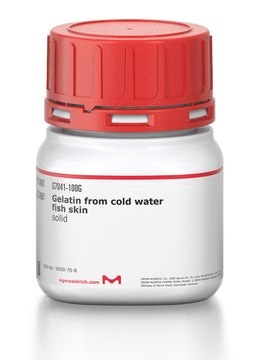00010402
OX-23 hybridoma cell line
Mouse x Mouse Hybridoma,
Sign Into View Organizational & Contract Pricing
All Photos(1)
About This Item
UNSPSC Code:
41106514
NACRES:
NA.81
Recommended Products
product name
OX-23 hybridoma cell line, Anti- Factor H, human
biological source
Mouse x Mouse Hybridoma
Quality Level
ImmunoDon
BALB/c mouse spleen
Myeloma
NS0
Reactivity
Anti-Factor H, human
technique(s)
cell culture | mammalian: suitable
isotype
IgG1
shipped in
dry ice
storage temp.
−196°C
Cell Line Origin
Mouse x Mouse hybridoma
Cell Line Description
The hybridoma line OX-23 was raised by immunizing BALB/c mice with Factor H and fusion of spleen cells with NS0 mouse myeloma cells. The antibody was shown to detect human complement control protein, Factor H. OX-23, also known as MRC OX-23, reduced the increase in cofactor activity observed in the presence of OX-24 (Sigma Catalogue no. 00010403). It was reported that OX-23 and OX-24 react with different epitopes on the Factor H molecule.
Immunogen
Human Factor H
Culture Medium
Subculture Routine
Maintain cultures between 3-9 x 100,000 cells/ml; 5% CO2; 37°C.
Other Notes
Additional freight & handling charges may be applicable for Asia-Pacific shipments. Please check with your local Customer Service representative for more information.
Disclaimer
This cell line has special release conditions: Commercial organisations are required to complete the ′Cell Line Release Authorisation for Research Use in Commercial Organisations′ release conditions form.
Storage Class Code
10 - Combustible liquids
WGK
WGK 3
Flash Point(F)
Not applicable
Flash Point(C)
Not applicable
Certificates of Analysis (COA)
Search for Certificates of Analysis (COA) by entering the products Lot/Batch Number. Lot and Batch Numbers can be found on a product’s label following the words ‘Lot’ or ‘Batch’.
Already Own This Product?
Find documentation for the products that you have recently purchased in the Document Library.
Daniel Ajona et al.
Cancer research, 64(17), 6310-6318 (2004-09-03)
The complement system is important in immunosurveillance against tumors. However, malignant cells are usually resistant to complement-mediated lysis. In this study, we examine the expression of factor H, an inhibitor of complement activation, and factor H-like protein 1 (FHL-1), its
Our team of scientists has experience in all areas of research including Life Science, Material Science, Chemical Synthesis, Chromatography, Analytical and many others.
Contact Technical Service



